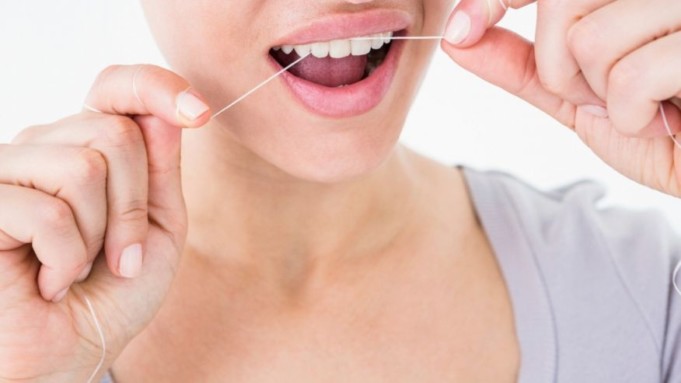During every trip to the dentist we are asked: “How often do you floss?” But the real question your dentist should be raising is, “Do you even floss AT ALL?”
According to the American Dental Association (ADA), 51 percent of Americans floss daily, 31 percent floss occasionally, and 18 percent do not floss at all.
The average length of floss used by person per year is 18 yards, 104 yards lesser than the required length.
Flossing is recommended to keep teeth in shape. Oral health is connected to physical health, so the way you keep your pearly whites healthy will be reflected on how healthy the rest of your body looks and functions.
Brush Or Floss First?
53 percent of Americans said they brush first, while the remaining 47 percent said they floss first. But which one is more appropriate?
Either way is fine, but the ADA suggests that when you floss first, the fluoride from the toothpaste has a better chance of reaching in between the teeth.
There are different varieties of floss for different teeth; braces or no braces, gap-toothed or not, there are braces designed to fit your needs and make the habit more convenient for you.
- Waxed/unwaxed floss
- Dental tape – for the gap toothed/teeth not tightly spaced
- Floss holder – pre-measured strands for those who have trouble maneuvering strings of floss
- Toothpick – usually found in most restaurants for the convenience of everyone
- Spongy floss – for those with braces and bridges
Be gentle when flossing and do it lightly to avoid bleeding gums. Flossing should NOT be painful.
Dentists advise that flossing should be done in push-pull and up-down motions against the side of each tooth. Contrary to popular belief, simply inserting the floss in between your teeth and instantly removing it is not effective.
Enamel Tells All
Compared to brushing, flossing has more access to the areas between teeth where bacteria live. It goes where toothbrush bristles cannot and fight the hidden bacteria that can potentially cause more damage than the ones which develop on the tooth surface.
Not making a regular habit of flossing may cause gum disease, cavities, and tooth decay which later on leads to stroke, heart disease or diabetes.
What few of us know is that flossing also protects against memory loss and head and neck cancer.
West Virginia School of Dentistry researchers are studying the relationship between gum disease and memory loss.
A memory test, oral health examination and blood work (which measures the level of inflammation) was conducted on people aged 60 and above to find a relationship between gum disease and memory loss. Results demonstrated that those who scored lowest on the memory test were prone to gum disease-causing bacteria and showed early symptoms of Alzheimer’s.
“…imagine the benefits of knowing that keeping the mouth free of infection could cut down on cases of dementia,” says associate dean Dr. Richard Crout.
This discovery makes it possible for dentists to help in determining and detecting early signs of memory problems in their senior patients just by looking at whether or not their dental health is well.
New York researchers also examined patients diagnosed with head and neck squamous cell carcinoma who had their periodontal health observed through alveolar (jaw) bone loss detected on panoramic x-rays. Each millimeter of bone loss in the patients studied was linked with a greater possibility of head and neck cancer, whether or not the patient was a smoker or alcoholic.
Flossing For Fertility
Roger Hart, a professor at the University of Western Australia in Perth conducted a study which verified that any woman that wants to get pregnant must visit their dentist habitually and be sure to floss and brush regularly.
Their results proved that women who had NO gum disease usually takes an average of five months to conceive, while those who suffered from gum disease took two months longer.
For men on the other hand, untreated dental problems and poor dental hygiene affected their fertility levels and sperm health as well.
Bonus: Flossing Saves You Financially
Bacteria buildup leads to tartar buildup, which creates cavities. Getting cavities treated takes about $75-100 per tooth. Worse cases like teeth that fall out cost even more, especially if you decide to get implants.
You could probably save thousands of dollars in tooth maintenance procedures just by taking the time to floss for two minutes after meals.
Would you rather invest a few bucks on some dental floss or be forced to pay higher dental bills in the future?
Author Bio:
Ayah Danica V. Granada is currently a content writer and editor for Scoopfed. Formerly a student journalist. Full time writer, part time bibliophile and TV series hoarder-slash-enthusiast. You can find her on Twitter @ayahgranada.













Yes, I think it is really essential to floss. It\’s kinda funny that there are some articles that say to stop flossing. And thanks for pointing out the proper way to floss. This is very important to avoid gum bleeding.
Nice read, thanks for sharing!
I teach my kids to floss early. That way they can clean those parts of their mouths that can\’t be reached by toothbrush alone. I want them to have that good habit.
Great read. People tend to neglect their dental health. Flossing really is just as important as brushing one\’s teeth.
I like the feeling of flossing. Nothing beats the feeling of removing what\’s in between the teeth.
I teach my kids to floss. Flossing is just as important as brushing your teeth. Thanks for posting about its benefits.
I always floss after brushing it feels complete that way. Without flossing it feels like there are some dirt stock on your teeth.